Capabilities vs Skills: What Exactly Makes Them Different?
Reading Time:
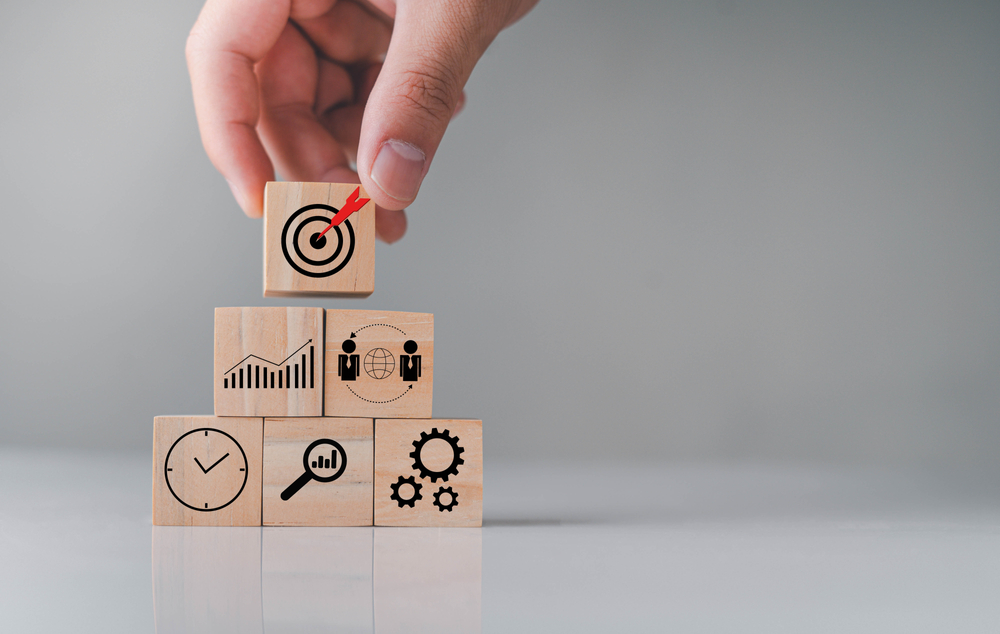
Lead the pack with the latest in strategic L&D every month— straight to your inbox.
SubscribeSkills refer to the capacity to perform a task, whilst capabilities allow outcomes to be generated. But what really makes them different?
You’ve probably heard the terms skills and capabilities used interchangeably in HR and L&D conversations. They sound similar, but they’re not the same—and treating them as if they are misses a critical opportunity for business impact.
Most of today’s dialogue centers on reskilling, upskilling, and building employees’ skills. That matters, but skills alone don’t transform organizations. Capabilities do. They’re what connect individual growth to enterprise performance, because capabilities can be developed at the employee level to drive outcomes at the organizational level.
In this article, we’ll unpack the key differences between skills and capabilities, and show how improving both—while focusing on capabilities first—creates sustainable business change.
What are capabilities?
Capabilities are a combination of knowledge, skills, tools, processes, and behaviors that define what a company does to fulfill business strategy and satisfy clients or stakeholders. When compiled in a framework, capabilities are used to drive outcomes that contribute to an organization’s performance, strategy, and brand identity.
What are skills?
Skills are the learned talent, knowledge, or expertise needed to perform a task. A skill is developed through experience or education. You can be technically skilled in order to do your job, or possess soft skills that impact your interpersonal relationships.
The difference between capabilities and skills
There are two major differences we want to walk you through: Purpose and longevity.
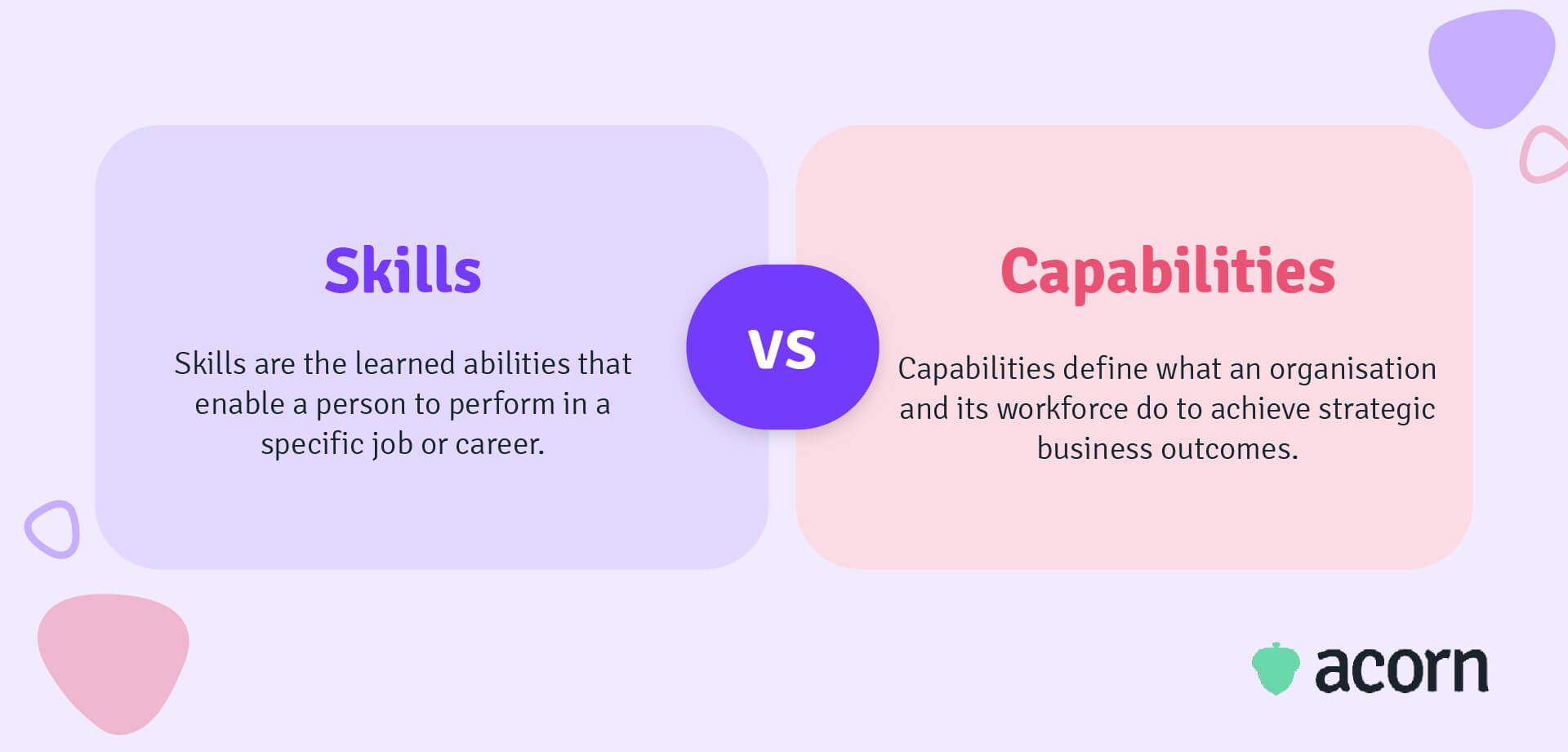
Difference 1: Purpose
Think of a single task in your job, like, say, verbal communication. That’s a skill: a learned ability you can practice and improve. But communication alone doesn’t move a business forward.
When you combine verbal communication with related skills like listening and empathy, you get a capability: something like Effectively communicate. Capabilities are collections of related skills, behaviors, and processes that drive outcomes. They’re what employees need to perform their roles, and what organizations need to achieve strategic goals.
For example, effective communication might be the difference between an employee who can hold a conversation and one who builds client relationships that grow revenue.
Difference 2: Longevity
Technical skills expire, fast. Within five years of gaining them, to be exact. Even soft or leadership skills, while longer-lived, still age out as the external environment evolves. Skills are tactical—important in the short term, but not built to last.
Capabilities, on the other hand, are strategic and enduring. They can be adopted from external frameworks, but need to be refined internally to reflect your organization’s culture and strategy. That’s why capabilities form the backbone of long-term success. They can be mapped to tasks, roles, and teams, ensuring they deliver business outcomes even as individual skills shift.
Think of it this way: skills are the individual moves, capabilities are the plays, and business outcomes are the scoreboard.
Why do I need to know the difference?
We’re not trying to say that skills aren’t important or that you shouldn’t consider them in workforce planning. They are simply one part of the picture.
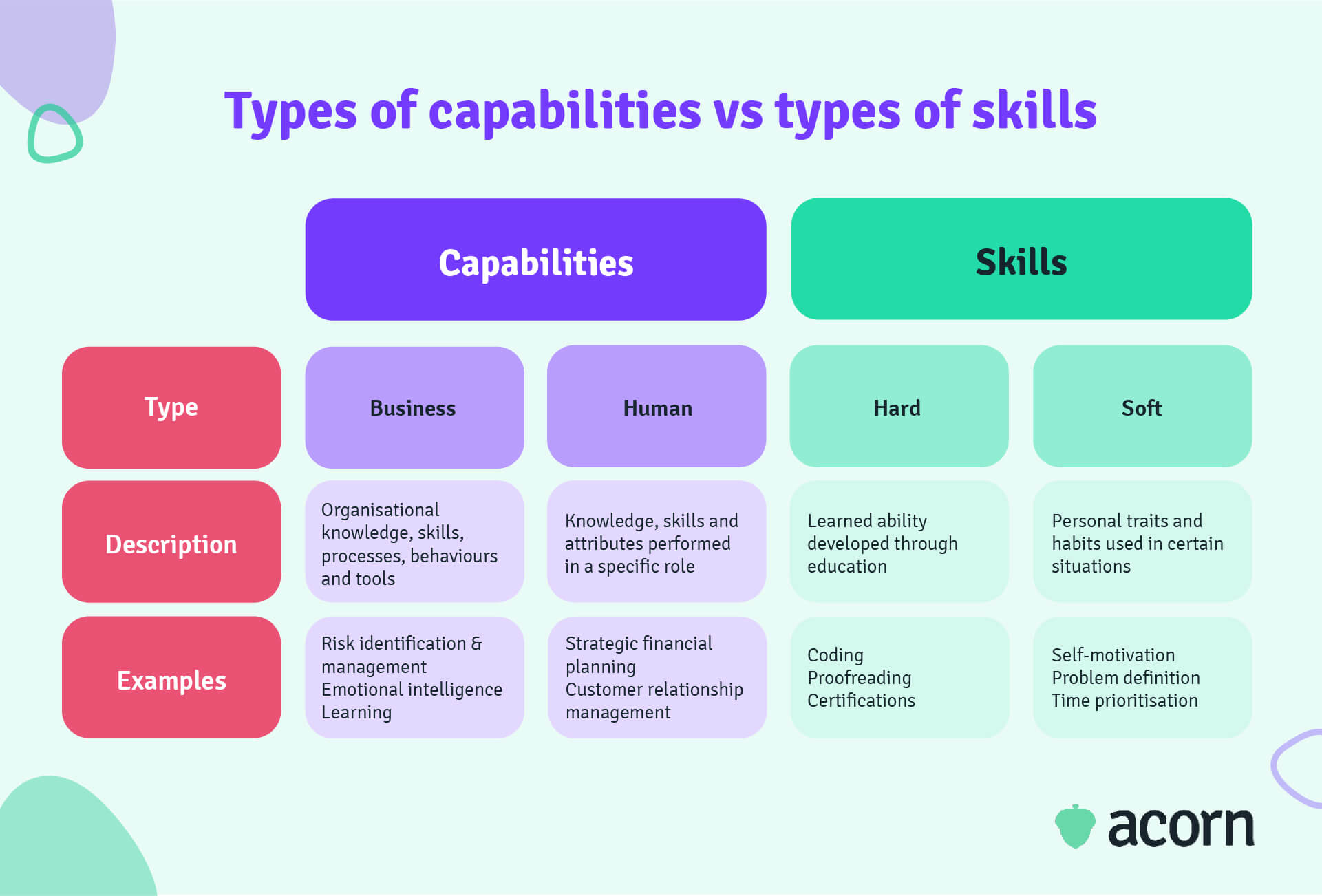
At the most foundational level, you need to identify the skills and abilities required for a specific job. But HR can’t afford to zoom in only on individual skills and lose sight of the bigger framework.
Here’s another way to look at it.
- Skills = the acquired ability to do something (e.g., communicating with teammates)
- Capabilities = the combination of abilities that impact outcomes (e.g., change management).
Focusing on capabilities emphasizes the strategic impacts of professional development and workforce planning. And when there are tangible links between L&D and ROI, you can better plan and argue for investments.
The issue is many legacy learning management systems are still built on a broken, skills-first ideology: the more content, the better. Learners are fatigued, leaders don’t see performance improvements, and organizations are left with a content catalog instead of a capability engine.
At Acorn, we pioneered the creation of a performance learning management system (PLMS) for this exact reason. The PLMS curates content for learners based on the specific capability needs of their roles, so you can provide contextual learning opportunities at scale, directly attributing learning to organisational performance by way of an AI-powered system that collects tangible evidence of behavioural change (not just learning completions).
Why capabilities are important in the workplace
Business pressures are only going to increase. Aside from the expected pressure to create more and new value, there are the unexpected downshifts to the pace of change to worry about.
And the thing about change is that you can’t use old methods for new challenges. Many employee training programs focus on developing skills and competency for a current role, with occasional desires on succession planning. But the problem is this is a reactive process. You risk losing talent and falling behind the mark without some forward thinking.
Capabilities define not only what you need now, but what you’ll need in the future. They help you:
- Identify and close skill gaps that matter most
- Prioritize at-risk or high-impact areas
- Build a continuous pipeline of leaders
- Future-proof your workforce.
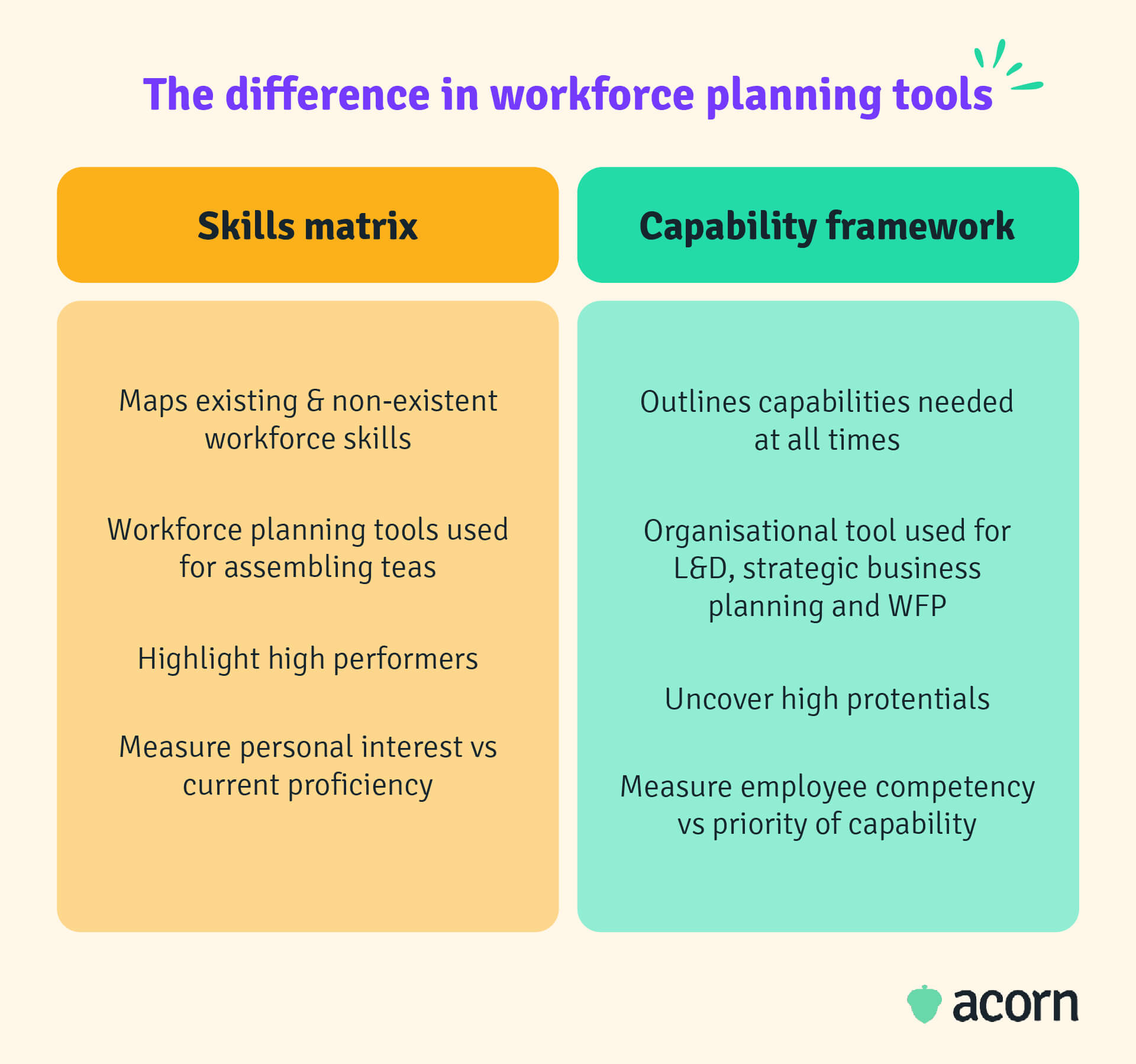
Capabilities also allow you to see employees beyond their current vertical. There’s often untapped potential in your workforce that can lead to attrition and productivity lag. When you consider jobs as groups of capabilities, you begin to see people in terms of their abilities and potential rather than the vertical they currently exist in. And this gives you the understanding you need for successful:
- Talent mobility. Particularly helpful for unexpected job vacancies or when crisis teams need to be assembled.
- Succession planning. Soft skills are harder to develop but increasingly crucial to business success, not least because they speak to a leader’s future ability to, well, lead others.
- Recruitment. Whether internal or external, you’ll be able to better match a suitable candidate to a given job when judging by their capabilities.
How to improve capabilities and skills
It’s all about empowering your employees to create new skills that enable them to apply capabilities post-training.
1. Link training to business needs
Personalizing training to career aspirations gives employees a reason to connect with it. You can boost that motivation and your ROI tenfold by tailoring career pathways to strategic objectives.
- Start with jobs most likely to be impacted by technological changes. This gives you a baseline of capabilities, transferable or otherwise, that those employees possess. You can then map the gaps between where they are and the role they may transition into.
- Identify your high-potential employees, and assess their capability gaps between their current roles and ones you’ll need soon, or that are currently vacant.
2. Embed learning in culture
Just as jobs are impacted by technological change, learning is disrupted by evolution. People are busier at work with more opportunities for distraction. Short-form learning in the moment of need is more necessary than ever.
If employees aren’t encouraged or able to access resources, you’re discouraging problem-solving. That knocks onto innovation and agility at the organizational level because if your employees can’t innovate, your business hasn’t got a chance.
3. Enable HR to think ahead
If you’re trying to achieve an entirely different future state, you’ll need different skills, knowledge, and behaviors in future than you do now. Even if you want to maintain and build on success, you need to give HR and L&D teams the tools to plan for that future.
Workforce planning analytics use the data you already have at your disposal (people data held in HRIS and learning data from an eLearning solution) to map the gaps holding you back.
HR and L&D also have oversight on other factors that can impact capability building, like:
- Overstaffing and understaffing.
- Organizational structure (are the right skills in the right place?)
- Costs, both in terms of labor and resources
- Mobility of talent.
Key takeaways
Skills are the tactics that get you through the day (like time management and teamwork), while capabilities work towards long-term success. Both are needed in an organization—but in the capability vs skill fight, capabilities are the heavyweight.
Your capabilities are defined in the context of your environment and goals. This means you can better find and develop talent, place it where it needs to be, and talk about it in a language all employees can understand. However, we still recommend you continue to develop both.
Your people’s skills will evolve. Your organization’s capabilities will shape where they take you.
Make sure to check out the next article, where we talk about how competencies differ from capabilities.
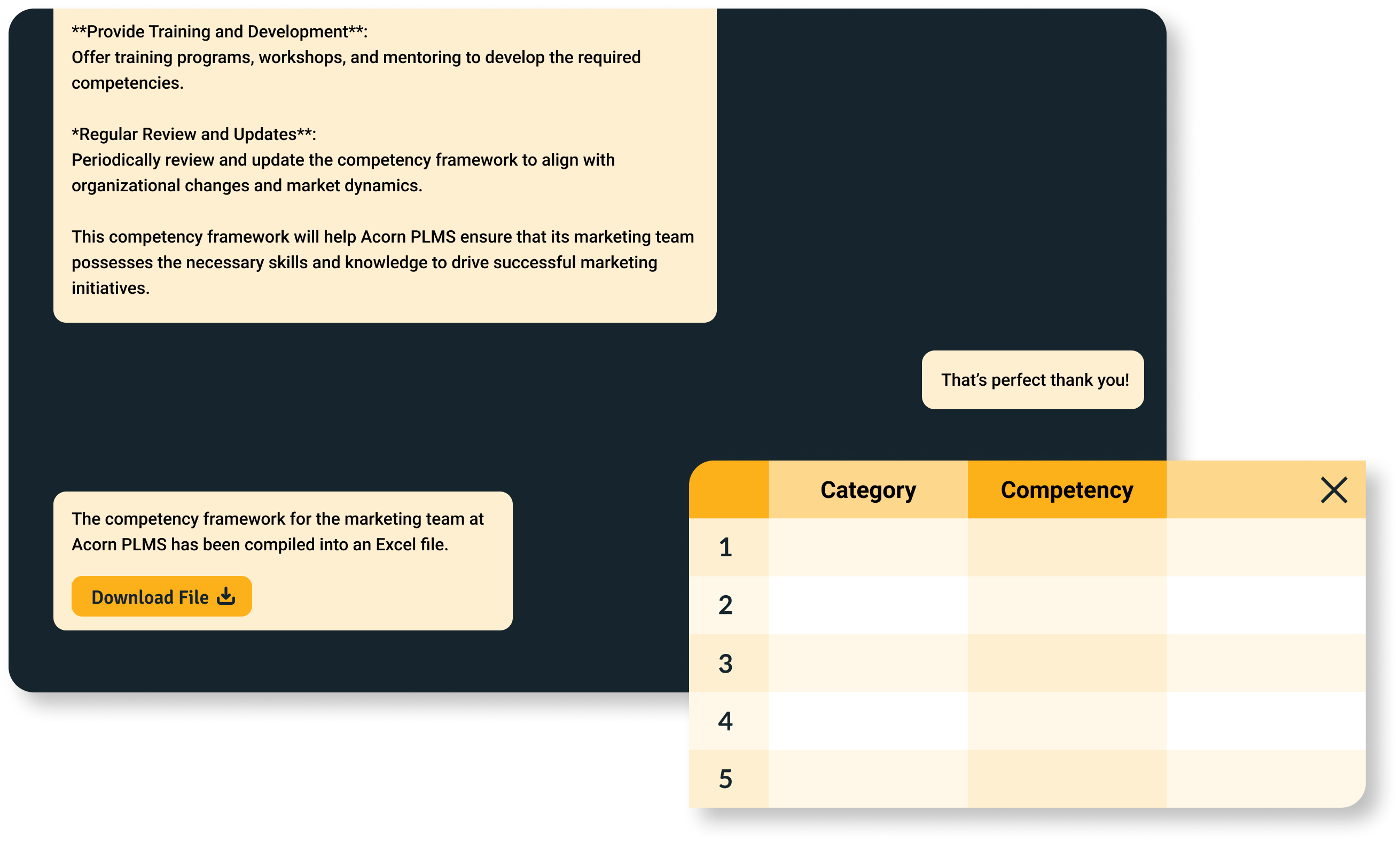
See the difference capabilities make by building a framework in less time than it takes to make a cup of coffee with our Capability Assistant.
BUILD YOUR FRAMEWORK